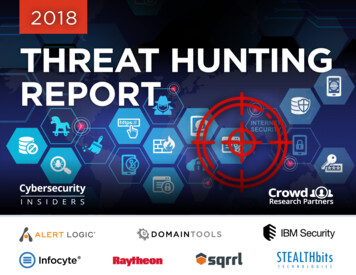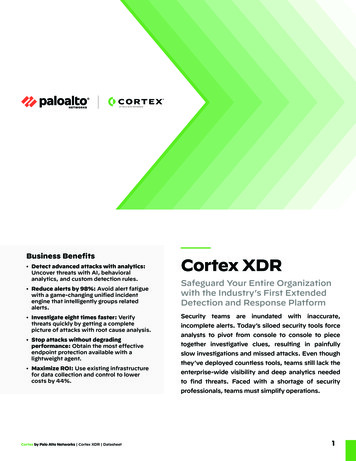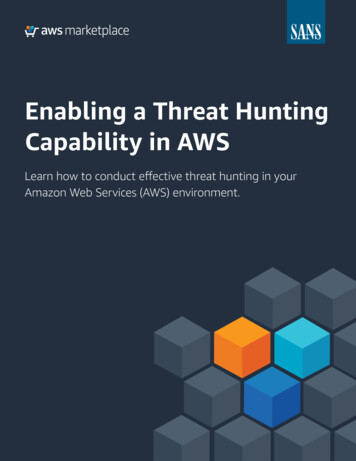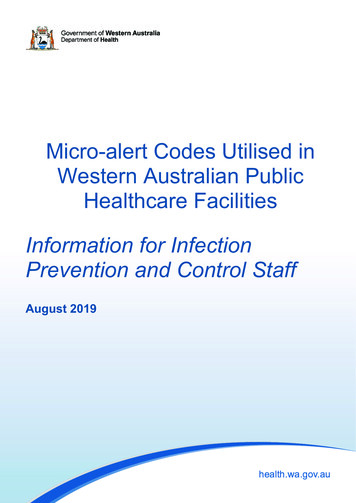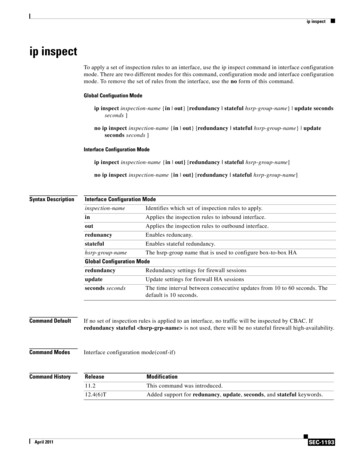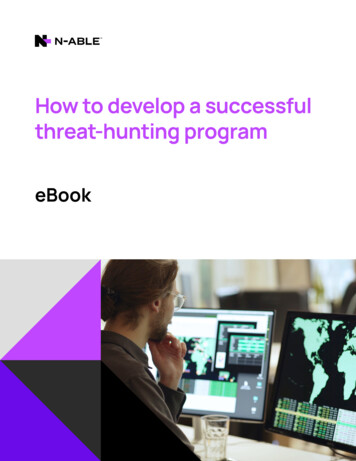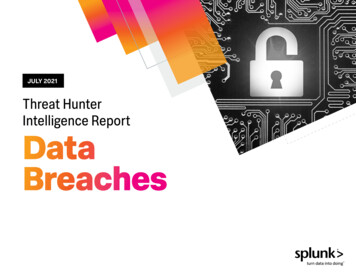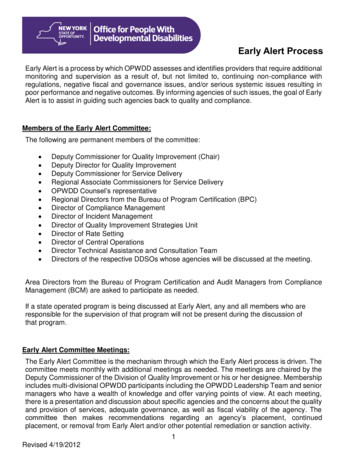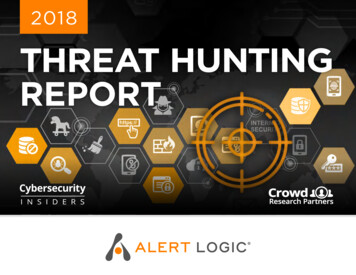
Transcription
2018THREAT HUNTINGREPORT
TABLE OF CONTENTSTHREAT HUNTING2018 SURVEYINTRODUCTION3KEY SURVEY FINDINGS4THREAT HUNTING5METHODOLOGY & DEMOGRAPHICS30ABOUT US31
INTRODUCTIONOrganizations are experiencing newand evolving cyberthreats that areincreasing in both sophisticationand frequency, often overwhelmingSecurity Operation Center (SOC) staff.In response to the new challenges,threat hunting is a developing securitypractice that focuses on proactivelydetecting and isolating advancedpersistent threats (APTs).In 2018, the Information Security Community on LinkedInconducted its second annual online research project onthreat hunting to gain further insights into the maturity andevolution of the security practice.The research confirms that organizations realize thatproactively uncovering security incidents pays off with earlierdetection, faster response, and denial of future exploits.We would like to thank our sponsor Alert Logic for supportingthis unique research.We hope you will enjoy the report.Thank you,Many SOCs are going through aposture shift as they are pivoting fromtraditional reactive security posturesto a hybrid approach that includesproactive hunting of threats.Holger SchulzeHolger SchulzeCEO and FounderCybersecurity 018 THREAT HUNTING REPORT3
KEY SURVEY FINDINGS1Threat hunting is gaining momentum - Organizations are increasingly utilizing threat hunting platforms (40 percent), up 5percentage points from last year’s survey. Threat hunting is gaining momentum and organizations are making the investmentin resources and budgets to shift from reacting to attacks to the creation of proactive threat hunting programs and dedicatedteams. Six out of 10 organizations in our survey are planning to build out threat hunting programs over the next three years.2Threat hunting delivers strong benefits - Organizations are growing more confident in their security teams’ ability to quicklyuncover advanced attacks. A third of respondents are confident to very confident in their threat hunting skills, a 7 percentagepoint increase over last year. Threat Hunting tools improve the speed of threat detection and response by a factor of 2.5xcompared to teams without dedicated threat hunting platforms. The top benefits organizations derive from threat huntinginclude improved detection of advanced threats (64 percent), followed by reduced investigation time (63 percent), and savedtime not having to manually correlate events (59 percent).3Threat management challenges - Detection of advanced threats remains the #1 challenge for SOCs (55 percent), followed bylack of security expertise (43 percent). 76 percent of respondents feel that not enough time is spent searching for emerging andadvanced threats in their SOC. Lack of budget (45 percent) remains the top barrier to SOCs who have not yet adopted a threathunting platform.4Most important threat hunting capabilities - The most important threat hunting capabilities for cybersecurity professionalsis threat intelligence (69 percent), followed by User and Entity Behavior Analytics (UEBA) (57 percent), automatic detection (56percent), and machine learning and automated analytics (55 percent).5Threat frequency and severity increases - A majority of 52 percent say threats have at least doubled in the past year. Based onthis trend, the number of advanced and emerging threats will continue to outpace the capabilities and staffing of organizationsto handle those threats.
THREAT HUNTING
SEVERITY & FREQUENCY OF CYBER THREATSCybersecurity professionals have an ongoing challenge of constantlydefending against increasing number of security threats, not only interms of volume of attacks but also their severity (damage and impact).In the past 12 months, the severity of security attacks directed atorganizations has increased. Nearly 52 percent of organizations haveexperienced at least a doubling of security attacks. Only 8 percent ofrespondents signaled a decrease in attacks.Which of the following best describes the change in severity(potential damage and impact) of security threats faced byyour organization in the past year?Over half of the SOCs (56 percent) polled have experiencedan increase in the frequency of cyber attacks over the last 12months. Only 6 percent say the frequency has decreased.The results further illustrate the need for organizations topivot from a purely reactive security stance to becomingmore proactive by hunting threats and adversaries.Which of the following best describes the frequency ofsecurity threats faced by your organization comparedto the previous year?Increased at therate of 5x or more5%Increased at therate of 5x or moreIncreased atthe rate of 4x6%Increased atthe rate of 4xIncreased atthe rate of 3x28%Increased atthe rate of 2xNot changed29%Not changedDon’t know 12%8%Increased atthe rate of 3x12%Increased atthe rate of 2xDecreased5%8%Decreased12%31%28%6%Don’t know 10%2018 THREAT HUNTING REPORT6
FINANCIAL IMPACT OF CYBER THREATSData breaches are becoming far more costly to manage. Nearly half (44 percent) of the respondents estimate the financial impact of anundetected data breach to be over half a million dollars. Alarmingly, 6 percent believe the cost to exceed 10 million dollars.What is the estimated financial impact of a security threat that goes undetected and results in a breach at your organization?50%44%21%Under 500,000 500,000to 999,999Nearly half of the respondents estimatethe financial impact of an undetected databreach to be over half a million dollars12% 1 million to 2.9 million8% 3 million to 5.9 million3% 6 million to 9.9 million6%More than 10 million2018 THREAT HUNTING REPORT7
THREAT HUNTING GOALSThe primary goal of any comprehensive cybersecurity program is to protect the organization’s resources and information against externaland internal threats. Cybersecurity professionals recognize that proactively hunting threats will reduce the overall risk to the organization.The top three objectives that threat hunting programs focus on: reducing exposure to external threats (56 percent), improving speed andaccuracy of threat response (52 percent) and reducing the number of breaches (49 percent).What are the primary goals of your organization’s threat hunting program?56%Reduce exposureto external threats45%Reduce timeto containment(prevent spread)52%Improve speed and accuracyof threat response42%Reduce attacksurface49%Reduce number ofbreaches and infections41%Reduce exposureto internal threatsReduce dwell time from infection to detection 39% Optimize resources spent on threat response 34% Other 8%2018 THREAT HUNTING REPORT8
ADOPTION OF THREAT HUNTINGThreat hunting platforms enable security analysts to discoveradvanced threats faster and at scale. The positive news isorganizations are increasingly utilizing threat hunting platforms(40 percent), up 5 percentage points from last year’s survey.Does your security team currently use a threat huntingplatform for security analysts?NO60%YES40%Threat hunting is gaining momentum and organizations aremaking the investment in resources and budget to shift fromreacting to attacks to the creation of proactive threat huntingprograms and dedicated teams. Six out of 10 organizations in oursurvey are planning to build out threat hunting programs over thenext three years.If you don’t have a threat hunting program in place already, areyou planning on building a threat hunting program in the nextthree years?YES60%NO40%2018 THREAT HUNTING REPORT9
BARRIERS TO THREAT HUNTINGFor the second year, lack of budget (45 percent) remains the top barrier to SOCs who have not yet adopted a threat hunting platform - thisis up 10 percentage points from last year.Fortunately, organizations are recognizing the importance of proactively hunting threats and made it both a higher priority (barrierlowered to 10 percent compared to 19 percent in the previous year) and addressed the lack of training (7 percent).What is the main reason your SOC does not have a dedicated threat hunting platform for its security analysts?45%Lack of budget15%10%7%4%Platform fatigue,we have many platformsNot a priorityfor our SOCLack of trainingon threat huntingLack of collaborationacross departmentsOther 19%2018 THREAT HUNTING REPORT10
BENEFITS OF THREAT HUNTINGThreat hunting platforms provide security analysts with a suite of powerful tools to provide earlier detection, reduce dwell time,and improve defenses for future attacks. The top benefits organizations derive from threat hunting include improved detectionof advanced threats (64 percent), followed closely by reduced investigation time (63 percent), and saved time not having tomanually correlate events (59 percent).What are the main benefits of using a threat hunting platform for security analysts?64%Improving detectionof advanced threats53%Reducing time wastedon chasing false leads63%Reducinginvestigation time50%Discovering threats thatcould not be discoveredotherwise59%Saving time frommanually correlating events49%Creating new waysof finding threatsConnecting disparate sources of information 49% Saving time scripting and running queries 42% Reducing extra and unnecessary noise in the system 39% Reducing attack surface 35% Other 7%2018 THREAT HUNTING REPORT11
IMPROVING CONFIDENCEOrganizations are becoming more confident in their security team’s ability to quickly uncover advanced attacks, compared to last year. Athird of respondents are confident to very confident in their team’s skills, a 7 percentage point increase over last year.How confident are you in your SOC’s ability to uncover advanced threats?33%38%20%26%3Not at all confident9%21of respondentsare confident tovery confident intheir team’s skills457%Very confident2018 THREAT HUNTING REPORT12
FAMILIARITY WITH THREAT HUNTINGThe survey reveals that cybersecurity professionals have recognized the growing significance of proactively hunting threats.Over the past year, industry awareness in the security category of threat hunting has increased. Seven in 10 respondents have someknowledge or are very knowledgeable about the topic. This is an increase of 13 percentage points compared to last year’s survey.How familiar are you with threat hunting?I am unfamiliar withthreat huntingI am aware of threat hunting,but have no knowledge14%18%19%13%I have some knowledgeon threat huntingI am very knowledgeable onthreat hunting (and activelyperform it for my organization)36%I am very knowledgeableon threat hunting(but don’t actively perform it)73%Have a moderate or highdegree of knowledgeabout threat hunting2018 THREAT HUNTING REPORT13
THREAT MANAGEMENT MATURITYSecurity Operations Centers continually face rapidly evolving threats and an increasing volume of advanced persistent threats (APTs).These challenges make it harder for cybersecurity teams to secure and defend their environments.From a maturity perspective, nearly 15 percent believe they are cutting-edge, up 8 percent from last year. However, 33 percent ofrespondents state that their capabilities are limited, a jump of nearly 6 percentage points higher from the previous year.Which of the following best reflects the maturity of your SOC in addressing emerging threats?We are cutting-edge,ahead of the curveWe are advanced,but not cutting-edgeWe are compliant,but behind the curveOur capabilities arelimited at this time15%28%24%33%2018 THREAT HUNTING REPORT14
THREAT HUNTERS IN SOCsA majority of organizations has less than 5 security professionals dedicated to threat hunting. The average number of threat hunters inSOCs is rising to 17 percent, up from 14 percent in 2017.Approximately, what percentage of employees at your SOC are threat hunting today?51%5 or fewer26%6-1011-5017%SOC employeesinvolved in threat hunting51 or more14%9%2018 THREAT HUNTING REPORT15
KEY SECURITY CHALLENGESThe survey results reveal that cybersecurity professionals prioritize detection of advanced threats (55 percent) as the top challenge fortheir SOC. Lack of expert security staff to mitigate such threats (43 percent) rose to second place.Notably, lack of confidence in automation tools catching all threats (36 percent), jumped from fifth place in last year’s survey to third today.Which of the following do you consider to be top challenges facing your SOC?55%43%The lack of expertsecurity staff to assistwith threat mitigationDetection ofadvanced threats(hidden, unknown,and emerging)36%35%31%29%28%Lack of confidencein automation toolscatching all threatsToo much timewasted on falsepositive alertsSlow response timeto find or detectadvanced threatsWorking with outdatedSIEM tools and SOCinfrastructureLack of properreporting toolsOther 7%7% Other2018 THREAT HUNTING REPORT16
TIME SPENT ON THREAT HUNTINGTraditionally, SOC’s approach to threats and the tools they use - such as antivirus, IDS, or security information and event management(SIEM) - are typically reactive response technologies.This is a reactive posture, whereas they spend a majority of their time reacting to threats, instead of proactively seeking new unknownthreats that enable early detection and quicker response. Nearly 3 in 4 (76 percent) respondents believe their SOC does not spendenough time proactively searching for new threats, slightly improving by 5 percentage points compared to last year.Do you feel enough time is spent searching for emerging and advanced threats at your SOC?24%YES76%NO2018 THREAT HUNTING REPORT17
THREAT HUNTING PRIORITYAlthough threat hunting is still nascent, more and more organizations recognize the value of building a threat hunting program to provideearly detection and reduce risk.Over 84 percent surveyed, agree that threat hunting should be a top security initiative, an increase of 5 percentage points from the yearbefore.What is your level of agreement with the following statement? “Threat hunting should be a top security initiative.”more than 3/4 of respondentsbelieve threat hunting is of major importance38%Strongly agree46%Somewhat agree11%4% 1%Neither agree Somewhatnor disagree disagreeStronglydisagree2018 THREAT HUNTING REPORT18
THREAT HUNTING ACROSS IT ENVIRONMENTSSecuring a single IT environment can be quite complex and challenging - orchestrating across multiple IT environments significantlyincreases the complexity. Nearly half (49 percent) of respondents manage multiple IT environments. Cybersecurity teams will need toevolve to manage and monitor these disparate environments.By employing tools and automation alongside SOC personnel, organizations can make better informed decisions, resulting in earlierdetection, faster responses, and reducing an adversary’s dwell time.What type of IT environment does your threat hunting program primarily focus on?49%22%17%4%Multiple ITenvironmentsOn premises/colocationManaged service/hostedPubliccloud8%Other2018 THREAT HUNTING REPORT19
SOURCING OF THREAT HUNTINGToday, a majority of organizations solely use in-house staff (56 percent) to proactively hunt threats. In the survey, over a third (33 percent)partner with Managed Security Services Providers (MSSP) to help. Threat hunting is a new security discipline for most organizations andmany are struggling to cope with their existing security threat workload.The good news, organizations are making the switch to include threat hunting as part of their security framework. They are discoveringthat proactive threat hunting can reduce the risk and impact of threats while improving defenses against new attacks.How is your threat hunting performed?56%In-housethreat huntingHybrid model with bothin-house threat huntingand third party managedsecurity service provider22%Outsourced to a thirdparty managed securityservice provider11%No proactivethreat hunting11%2018 THREAT HUNTING REPORT20
THREAT HUNTING FREQUENCYEarly detection of cyber breaches and rapid response can mitigate the severity and impact of damages.Forty-two percent of organizations continuously and actively hunt threats, followed by 36 percent who perform threat hunting onlyreactively, as the need arises. Thirteen percent do not perform any threat hunting.How frequently does your organization perform threat hunting?42%36%9%ContinuouslyAd-hoc,as need arisesScheduled atcertain intervals(daily, weekly,monthly)13%We don'tperformthreat hunting2018 THREAT HUNTING REPORT21
ATTACK DISCOVERYA majority of organizations (58 percent) discovers most attackswithin 7 days. A third of organizations report dwell times over 30days. Nearly all respondents agree that attackers dwell on a networkfor some period of time before they’re discovered by the SOC.On average, how many days do attackers who breached yoursecurity defenses dwell in your network before they arediscovered by your SOC?30DAYSAverage time attackersdwell on networksuntil discoveredSOCs report they are missing an average of 39 percent ofsecurity threats. This represents only a small improvementover the 40 percent of missed threats SOCs reported in 2017.What percentage of emerging and advanced threats aremissed by traditional security tools?39%MISSEDSecurity ThreatsUp to .16%1 day26%3 days16%7 days9%14 days14%30 days60 days100 days500 days6%8%5%58%within7 days61%DETECTEDSecurity Threats2018 THREAT HUNTING REPORT22
THREAT HUNTING PERFORMANCEWhen asked to estimate the amount of time it takes to detect and address threats with vs. without a threat hunting platform, SOCsutilizing threat hunting platforms reported an average performance improvement of 2.5 faster detection and response time.On average, how many hours does it take to detect and respond to threats WITH / WITHOUT a threat hunting platform?92%75%Time to detect& respond48 hoursspeed improvement of threatdetection and responseWITH a threat hunting platform24 hours5%12%2.5x2%1%1%4%3%4%2%72 hours96 hours120 hoursmore than120 hoursWITHWITHOUT A THREAT HUNTING PLATFORM2018 THREAT HUNTING REPORT23
DATA COLLECTION PRIORITIESThreat hunting includes a wide array of data sources to detect anomalies and suspicious activity. Most organizations prioritize Firewall andIPS logs as the most important data sources to collect and review, as the top choice at 69 percent, followed by web and email filter trafficat 63 percent, and network traffic at 61 percent.Bottom Line: there are numerous security datasets to investigate. The best practice is not to depend solely on one, but to gather,normalize and analyze a variety of sources for a more complete, timely, and accurate picture.What kind(s) of data does your security organization collect and analyze?69%63%Firewall &IPS logs55%Endpoint activityWeb and emailfilter traffic54%Active directory61%Networktraffic53%38%37%DNS trafficServer trafficUser behaviorPacket sni/tcpdump 37% System logs 36% File monitoring data 32% Don’t know 12% Other 6%2018 THREAT HUNTING REPORT24
TIME SPENT ON THREAT HUNTINGRespondents spend an average 60 percent of their time with alert triage and reacting to security threats compared to40 percent of time spent proactively seeking threats.In a typical week, what percentage of your threat management time is spent with alert triage or reactive response to security threatsversus engaging in proactive and innovative detection methods?VS.40%Proactivelydetecting threats60%Reacting tosecurity threats2018 THREAT HUNTING REPORT25
THREAT INDICATORSUnderstanding Indicators of Compromise (IOCs) allows organizations to develop effective defense methodologies that help withrapid detection, containment, and denial of future exploits. Knowing what IOCs to look for aids cybersecurity professionals in threattriage and remediation.Our research reveals that hunt teams most frequently investigate behavioral anomalies (67 percent), followed by IP addresses (58percent), and tied for third are both domain names and denied/flagged connections at 46 percent.What kinds of indicators are most frequently investigated by your hunt team?67%58%46%IP addressesDomain namesBehavioral anomalies(unauthorized accessattempts, etc.)46%Denied/flaggedconnections32%File namesNot sure/Other 24%2018 THREAT HUNTING REPORT26
KEY THREAT HUNTING CAPABILITIESThe most important capability that cybersecurity professionals consider critical to their threat hunting tool suite is threatintelligence (69 percent).User and Entity Behavior Analytics (UEBA) (57 percent), automatic detection (56 percent), machine learning and automatedanalytics (55 percent) and full attack lifecycle coverage (55 percent) round out the top five capabilities.What capabilities do you consider most important regarding the effectiveness of a threat hunting tool?69%Threat intelligence57%56%55%55%User and Entity BehaviorAnalytics (UEBA)Automatic detectionMachine learning andautomated analyticsFull attacklifecycle coverageVulnerability scanning 47% Integration and normalization of multiple data sources 45% Intuitive data visualization 44% Automated workflows 43% Fast, intuitive search 43% Other 5%2018 THREAT HUNTING REPORT27
THREAT HUNTING TECHNOLOGIESThe market for threat hunting tools is still maturing, with new entrants emerging. Organizations cast a wide net and use multiple technologiestogether to achieve deeper visibility across their infrastructure to help identify new threat patterns. Many continue to rely on traditionaltools and methods of prevention/detection (e.g., firewalls, IDS, SIEM, etc.) as part of their threat hunting posture.The top three technologies that organizations utilize for threat hunting are NGFW, IPS, AV (55 percent), SIEM (50 percent) and anti-phishingor other messaging security software (49 percent). Interestingly, threat intelligence (39 percent) ranked fourth in this year’s survey.Which technologies do you use as part of your organization’s threat hunting approach?55%NGFW, IPS, AV,web applicationfirewall, etc.50%49%39%34%32%SIEMAnti-phishing orother messagingsecurity softwareThreat intelligenceplatformEnrichment andinvestigation toolsVulnerabilitymanagementNetwork IDS 31% Orchestration (e.g., Phantom, Hexadite, Resilient, etc.) 11% Not sure/Other 19%2018 THREAT HUNTING REPORT28
THREAT HUNTING INTEGRATIONOrganizations are integrating a multitude of technologies into their threat hunting platform to increase scope, speed, and accuracy ofthreat detection and response. Incident response (71 percent) takes the top spot of technologies security professionals would like to seeintegrated into threat hunting platforms, followed by SIEM (63 percent). Tied for third place (56 percent) are ticket systems and ActiveDirectory.With what systems would you like your threat hunting platform to integrate?71%Incident response63%SIEM56%Active directory56%27%19%9%8%Ticket systemNACFile activitymonitoringCI/CD, deploymentorchestrationUEBAOther 9%2018 THREAT HUNTING REPORT29
METHODOLOGY & DEMOGRAPHICSThe 2018 Threat Hunting Report is based on the results of an online survey of over 461 cybersecurity and IT professionals to gainmore insight into the state of threat management in SOCs. The respondents range from security analysts and IT managers toCISOs. The respondents reflect a representative cross section of organizations of varying sizes across many industries, rangingfrom financial services to telecommunications and healthcare.D EPARTM ENT33%IT securityIT operations24%Security Operations Center 9%Product ManagementOtherJ O B LE VEL24%12%Security AnalystIT Manager, Director or CIO11%10%9%Threat AnalystSecurity Manager8%26%CSO, CISO or VP of SecuritySystems AdministratorOtherCO M PAN Y SIZE35%Less than 100100-49913%500-9991,000-4,9999%15%5,000 - 9,9996%22%10,000 or moreI N DUSTRY20%GovernmentOther17%Technology14%Financial Services, banking or s or ISPHealthcareRetail or ecommerce2018 THREAT HUNTING REPORT30
CONTACT USResources Available To YouLet Alert Logic keep you up-to-date of the latest developments in the cloud security industry – from emerging security threats to the mostrecent changes in compliance regulations through a variety of resources including:Alert Logic BlogSubscribe to our blog which provides in-depth threat intel and IT security best practices from Alert Logic lert Logic 2017 Cloud Security ReportThe security threat landscape is changing as the adoption of cloud computing continues to grow, and cyber criminals areshifting their focus accordingly. The 2017 Cloud Security Report analyzes real-world security data to identify cyber-attacktrends in attacker behavior and security ud-security-report-2017/On-Demand WebinarUnderstanding Your Cloud Attack Surface - Insights from the 2017 Cloud Security Report.Understand how today’s vulnerabilities are being exploited and key strategies you can adopt to increase security andmanage rom-the-2017-cloud-security-report/U.S. 877.484.8383 U.K. 44 (0) 203.011.5533INFO@ALERTLOGIC.COM ALERTLOGIC.COM
hunting platform. Most important threat hunting capabilities - The most important threat hunting capabilities for cybersecurity professionals is threat intelligence (69 percent), followed by User and Entity Behavior Analytics (UEBA) (57 percent), automatic detection (56 percent), and machine learning and automated analytics (55 percent).
